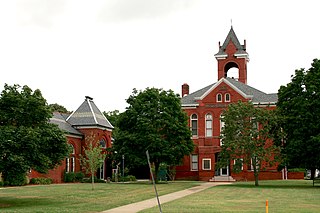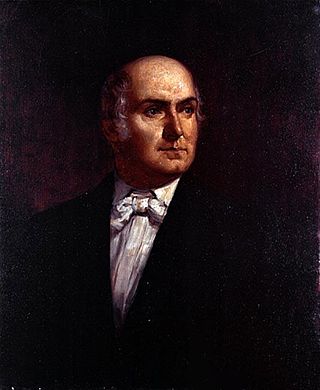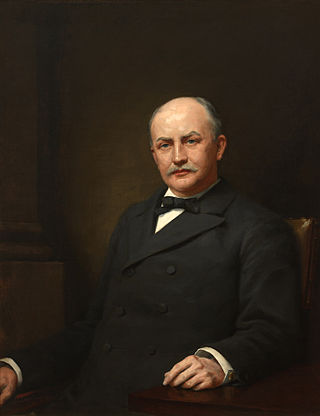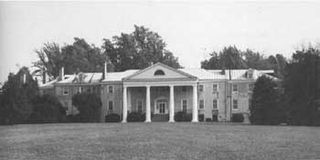Related Research Articles

Accomac is a town in and the county seat of Accomack County, Virginia, United States. The population was 526 at the 2020 census.

Susan Agnes Macdonald, 1st Baroness Macdonald of Earnscliffe, was the second wife of Sir John A. Macdonald, the first Prime Minister of Canada.

Poplar Forest is a plantation and plantation house in Forest, Bedford County, Virginia. Founding Father and third U.S. president Thomas Jefferson designed the plantation, and used the property as both a private retreat and a revenue-generating plantation. Jefferson inherited the property in 1773 and began designing and working on the plantation in 1806. While Jefferson is the most famous individual associated with the property, it had several owners before being purchased for restoration, preservation, and exhibition in 1984.

Abel Parker Upshur was an American lawyer, planter, judge and politician from the Eastern Shore of Virginia. Active in Virginia state politics for decades, with a brother and a nephew who became distinguished U.S. Navy officers, Judge Upshur left the Virginia bench to become the Secretary of the Navy and Secretary of State during the administration of President John Tyler, a fellow Virginian. He negotiated the treaty that led to the 1845 Texas annexation to the United States and helped ensure that it was admitted as a slave state. Upshur died on February 28, 1844, when a gun on the warship USS Princeton exploded during a demonstration.

Charles Frederick Crisp was a United States political figure. A Democrat, he was elected as a congressman from Georgia in 1882, and served until his death in 1896. From 1890 until his death, he led the Democratic Party in the House, as either the speaker of the House or House minority leader. He was the father of Charles R. Crisp who also served in Congress.

James Madison's Montpelier, located in Orange County, Virginia, was the plantation house of the Madison family, including Founding Father and fourth president of the United States James Madison and his wife, Dolley. The 2,650-acre (10.7 km2) property is open seven days a week with the mission of engaging the public with the enduring legacy of Madison's most powerful idea: government by the people.

Francis Wayles Eppes was a planter and slave owner from Virginia who became a cotton planter in the Florida Territory and later civic leader in Tallahassee and surrounding Leon County, Florida. After reaching legal age and marrying, Eppes operated the Poplar Forest plantation which his grandfather President Thomas Jefferson had established in Bedford County, Virginia, which he inherited. However, in 1829 he moved with his family to near Tallahassee, Florida. Long interested in education, in 1856 Eppes donated land and money to designate a school in Tallahassee as one of the first two state-supported seminaries, now known as Florida State University. He served as president of its board of trustees for eight years.

Shepherd Hall, also known as Monument Place and formerly as Stone Mansion, is a historic house listed on the National Register of Historic Places in the city of Wheeling in the U.S. state of West Virginia. It is located in the Elm Grove area of Wheeling, Ohio County, West Virginia.
Thomas Henry Bayly was a nineteenth-century politician, slave owner, lawyer and judge from Virginia, and the son of Congressman Thomas M. Bayly.
Robert Taylor was a nineteenth-century politician and lawyer from Virginia.
Frances Jones Dandridge was the mother of Martha Washington, the first First Lady of the United States. She was born in New Kent County, Virginia. Her father Orlando Jones and maternal grandfather Colonel Gideon Macon served on the House of Burgesses in Colonial Virginia. Her parents were prosperous Virginia landowners.

Howe Peter Browne, 2nd Marquess of Sligo, was an Irish peer and colonial governor, styled Viscount Westport until 1800 and Earl of Altamont from 1800 to 1809.

Bel Air Manor is a colonial-era plantation manor located in Minnieville, Prince William County, Virginia. Built in 1740 as the Ewell family seat, the home was regularly visited by Thomas Jefferson and George Washington, who was a cousin. It later served as the home of Mason Locke Weems (1759–1825), the first biographer of George Washington and the creator of the cherry tree story. Extraordinarily well preserved for its age, Bel Air was added to the National Register of Historic Places in 1970. Today, Bel Air remains a private residence and a working farm. Bel Air is not to be confused with "Bel Aire", a similarly named house five miles to the east.

Winney Grimshaw was an enslaved African-American woman at Mount Airy Plantation in Richmond County, Virginia. The Grimshaws are one of the most well-documented enslaved families who lived at Mount Airy. Though the Grimshaws were a well-regarded slave family at Mount Airy, it wasn't enough to keep their master from dissolving her family ties.
Edith Hern Fossett (1787–1854) was an African American chef who for much of her life was a slave for Thomas Jefferson before being freed. Three generations of her family, the Herns, worked in Jefferson's fields, performed domestic and leadership duties, and made tools. Like Hern, they also took care of children. She cared for Harriet Hemings, the daughter of Sally Hemings, at Thomas Jefferson's Monticello plantation when she was a girl.

Ann Randolph Meade Page was an Episcopal slavery reformer. She was raised in her birth family with slaves and her husband was among the largest slaveholders in Frederick County, Virginia. She did not believe in slavery, and while she was unable to free slaves, she focused on improving their conditions by teaching them to read and write, religion, a wide range of domestic skills and trades. After the founding of the American Colonization Society and afer the death of her husband, she emancipated enslaved people and prepared them to leave the United States for the colony of Liberia in Africa, where they and their family members would live free.
Sarah Johnson was an African American woman who was born into slavery at Mount Vernon, George Washington's estate in Fairfax, Virginia. She worked as a domestic, cleaning and caring for the residence. During the process, she became an informal historian of all of the mansion's furnishings. After the end of the Civil War, she was hired by the Mount Vernon Ladies' Association, ultimately becoming a council member of the organization. She bought four acres of Mount Vernon land to establish a small farm. The book Sarah Johnson's Mount Vernon (2008) tells the story of her life within the complex community of people who inhabited Mount Vernon.

The history of slavery in Colorado began centuries before Colorado achieved statehood when Spanish colonists of Santa Fe de Nuevo México (1598–1848) enslaved Native Americans, called Genízaros. Southern Colorado was part of the Spanish territory until 1848. Comanche and Utes raided villages of other indigenous people and enslaved them.
Ellen Garrison Jackson Clark was an African American educator, abolitionist and early Civil Rights activist, whose defiance of "whites only" social spaces has been compared to Rosa Parks' actions in the 20th century. After decades spent crisscrossing the East Coast, the South and Midwest in the service of teaching literacy, Clark eventually settled in Pasadena, California for health reasons. She was buried in an unmarked grave in Altadena. In 2021, the Altadena Historical Society successfully lobbied to provide Clark's grave with a memorial headstone.
References
- ↑ Brooklyn Daily Eagle 12 Mar 1882
- ↑ Beganski, Andre (June 15, 2021). "Former slave receives tombstone 125 years after her death". Forest Hills Times.
- ↑ "Freed slave honored with cemetery plaque".
- ↑ Sea Cliff News, 26 Sept 1886
- ↑ "Artists's rendering of bronze memorial" (PDF). The Friends of Maple Grove – via bbk12e1-cdn.myschoolcdn.com.
- ↑ "Kew-Forest Students Collaborate with Maple Grove Cemetery to Honor Formerly Enslaved Woman, Millie Tunnel". 2 July 2021.